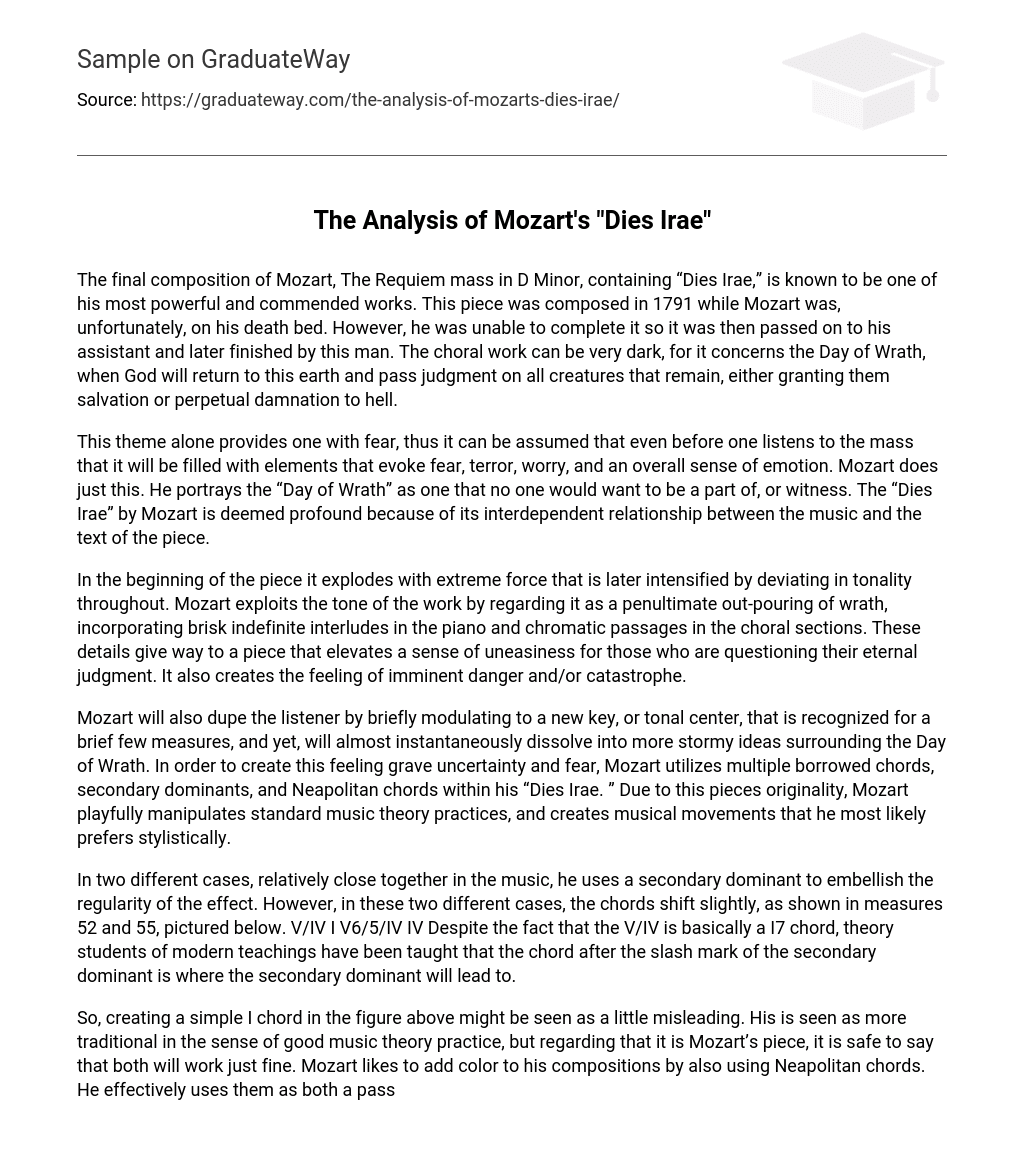The final composition of Mozart, The Requiem mass in D Minor, containing “Dies Irae,” is known to be one of his most powerful and commended works. This piece was composed in 1791 while Mozart was, unfortunately, on his death bed. However, he was unable to complete it so it was then passed on to his assistant and later finished by this man. The choral work can be very dark, for it concerns the Day of Wrath, when God will return to this earth and pass judgment on all creatures that remain, either granting them salvation or perpetual damnation to hell.
This theme alone provides one with fear, thus it can be assumed that even before one listens to the mass that it will be filled with elements that evoke fear, terror, worry, and an overall sense of emotion. Mozart does just this. He portrays the “Day of Wrath” as one that no one would want to be a part of, or witness. The “Dies Irae” by Mozart is deemed profound because of its interdependent relationship between the music and the text of the piece.
In the beginning of the piece it explodes with extreme force that is later intensified by deviating in tonality throughout. Mozart exploits the tone of the work by regarding it as a penultimate out-pouring of wrath, incorporating brisk indefinite interludes in the piano and chromatic passages in the choral sections. These details give way to a piece that elevates a sense of uneasiness for those who are questioning their eternal judgment. It also creates the feeling of imminent danger and/or catastrophe.
Mozart will also dupe the listener by briefly modulating to a new key, or tonal center, that is recognized for a brief few measures, and yet, will almost instantaneously dissolve into more stormy ideas surrounding the Day of Wrath. In order to create this feeling grave uncertainty and fear, Mozart utilizes multiple borrowed chords, secondary dominants, and Neapolitan chords within his “Dies Irae. ” Due to this pieces originality, Mozart playfully manipulates standard music theory practices, and creates musical movements that he most likely prefers stylistically.
In two different cases, relatively close together in the music, he uses a secondary dominant to embellish the regularity of the effect. However, in these two different cases, the chords shift slightly, as shown in measures 52 and 55, pictured below. V/IV I V6/5/IV IV Despite the fact that the V/IV is basically a I7 chord, theory students of modern teachings have been taught that the chord after the slash mark of the secondary dominant is where the secondary dominant will lead to.
So, creating a simple I chord in the figure above might be seen as a little misleading. His is seen as more traditional in the sense of good music theory practice, but regarding that it is Mozart’s piece, it is safe to say that both will work just fine. Mozart likes to add color to his compositions by also using Neapolitan chords. He effectively uses them as both a passing function as well as a neighboring function. In the example provided above, Mozart cleanly exercises the passing rule of the Neapolitan 6th chord.
Refer to Figure 2, measures 36 and 37: D Minor: V7 i i N6 ( in passing function) ?7 Mozart clearly integrates the Neapolitan chord correctly, in the practical theory sense, and also very well in the application of the passing function. Although the Neapolitan does not arrive at a dominant right away, as preferred, the i chord between the Neapolitan and the dominant serves as a minor interruption that does not steer the passage away from landing on the V chord.
In conclusion, Mozart’s “Dies Irae” is an ominous musical composition, with multiple modulating tonal centers, creating urgency within the voices and a sense of impending doom throughout the accompinament. The complex patterns through which the chorale follows are very involved, and sharpen the impact of the gravity of the literal life-or-death situation. Mozart’s composition works in the practical sense of theory, and yet he uses his own style and elegance to bend the rules to fit his own stylistic taste.





